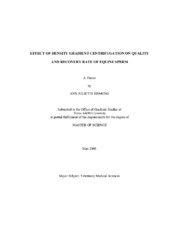| dc.contributor.advisor | Varner, Dickson D. | |
| dc.creator | Edmond, Ann J. | |
| dc.date.accessioned | 2010-07-15T00:11:24Z | |
| dc.date.accessioned | 2010-07-23T21:43:03Z | |
| dc.date.available | 2010-07-15T00:11:24Z | |
| dc.date.available | 2010-07-23T21:43:03Z | |
| dc.date.created | 2009-05 | |
| dc.date.issued | 2010-07-14 | |
| dc.date.submitted | May 2009 | |
| dc.identifier.uri | https://hdl.handle.net/1969.1/ETD-TAMU-2009-05-311 | |
| dc.description.abstract | Density gradient centrifugation of sperm is a common assisted-reproduction
procedure in humans used to improve semen quality. The technique allows sperm
separation based on their isopycnic points. Sperm with morphologic abnormalities are
often more buoyant, leading to their retention above centrifuged density gradients, with
structurally normal sperm passing through the gradient. Three experiments were
conducted to evaluate the effects of tube size, sperm number following centrifugation,
and density gradient volume (height) on stallion sperm quality and recovery rate in
sperm pellets following centrifugation. In all three experiments, equine semen was
initially centrifuged to increase sperm concentration. In Experiment 1, one-mL aliquots
were layered over EquiPure? Bottom Layer (1-Layer) or over-tiered EquiPure? Top
and Bottom Layers (2-Layer). For Experiment 2, one-mL aliquots were layered over
three different heights of EquiPure? Bottom Layer in 15-mL or 50-mL conical-bottom
tubes. For Experiment 3, four different aliquots containing a sperm load of 1-4x were
layered over a constant volume of EquiPure? Bottom Layer in 15-mL or 50-mL conical bottom tubes. The tubes were then centrifuged. Resulting sperm pellets were evaluated
for morphologic quality, DNA integrity, motility and recovery rate.
Sperm-EquiPure? centrifugation yielded improvements in motility, morphology
and DNA integrity parameters (P<0.05), as compared to controls. The 1-Layer method
resulted in a higher recovery rate than the 2-Layer method (P<0.05). Sperm processed in
the 15-mL tubes yielded higher velocity and higher recovery rates than sperm processed
in the 50-mL tubes (P<0.05). Within tube type, gradient volume did not impact
parameters of semen quality or recovery rate. An increase in sperm number for density
gradient centrifugation resulted in a decreased recovery rate (P<0.05) when 15-mL tubes
were used. | en |
| dc.format.mimetype | application/pdf | |
| dc.language.iso | eng | |
| dc.subject | Semen | en |
| dc.subject | Sperm | en |
| dc.subject | Density Gradient Centrifugation | en |
| dc.subject | Stallion | en |
| dc.title | Effect of Density Gradient Centrifugation on Quality and Recovery Rate of Equine Sperm | en |
| dc.type | Book | en |
| dc.type | Thesis | en |
| thesis.degree.department | Large Animal Clinical Sciences | en |
| thesis.degree.discipline | Veterinary Medical Sciences | en |
| thesis.degree.grantor | Texas A&M University | en |
| thesis.degree.name | Master of Science | en |
| thesis.degree.level | Masters | en |
| dc.contributor.committeeMember | Brinsko, Steve P. | |
| dc.contributor.committeeMember | Love, Charles C. | |
| dc.contributor.committeeMember | Forrest, David W. | |
| dc.type.genre | Electronic Thesis | en |
| dc.type.material | text | en |


